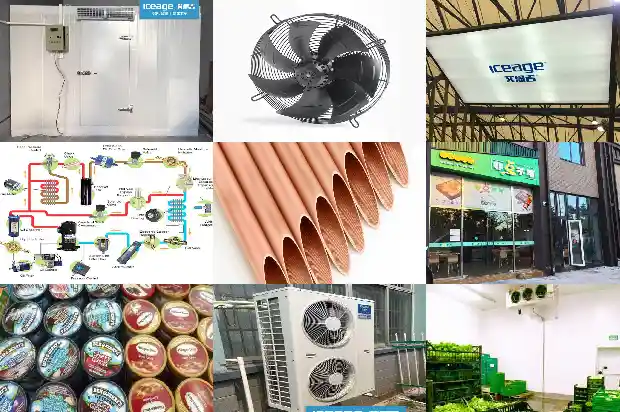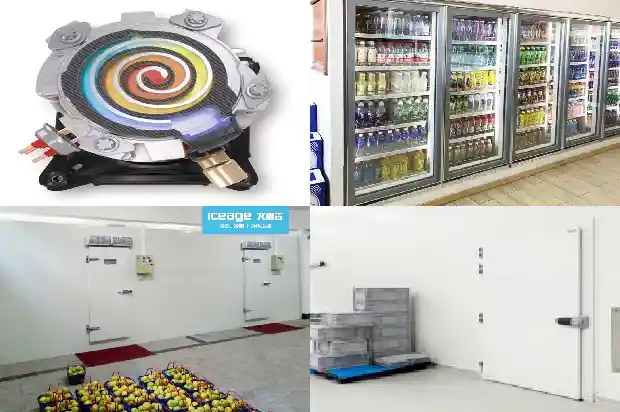Automated Control of Refrigeration Systems
2024-09-17
With the development of technology, regarding the automatic control of refrigeration systems, from relay control to single-chip microcomputer control, PLC control, industrial control computer control, etc., the technical means are continuously upgrading and progressing. Let's learn about these different control modes.
Relay control:
It adopts the method of hard wiring, using the series or parallel connection of the mechanical contacts of relays and the delayed action of time-delay relays to achieve combined control. This control mode has a large number of connections, high power consumption, and poor flexibility and expandability. It is usually used in circuits for automatic control to achieve functions such as automatic adjustment, safety protection, and circuit conversion. There are types such as voltage relays, current relays, time relays, and pressure relays. Now there are also some new electromagnetic relays, which are applied to signal transmission and weak electrical power switching in electronic control equipment.
Picture
It adopts the method of hard wiring, using the series or parallel connection of the mechanical contacts of relays and the delayed action of time-delay relays to achieve combined control. This control mode has a large number of connections, high power consumption, and poor flexibility and expandability. It is usually used in circuits for automatic control to achieve functions such as automatic adjustment, safety protection, and circuit conversion. There are types such as voltage relays, current relays, time relays, and pressure relays. Now there are also some new electromagnetic relays, which are applied to signal transmission and weak electrical power switching in electronic control equipment.
Picture
Single-chip microcomputer control:
It refers to using a dedicated chip to control the devices of the refrigeration system, such as sampling and controlling the controlled parameters and necessary safety protection functions. It integrates the CPU, RAM, ROM, and I/O onto one chip, so it is called a single-chip microcomputer. In fact, it is a microcontroller, that is, it realizes the control of the adjusted parameters through input and output. For example, in a household air conditioner, when using single-chip microcomputer control, by receiving signals from the remote control, as well as indoor temperature, heat exchanger temperature, compressor status, etc., the operation of the air conditioner is controlled. Some newly developed single-chip microcomputers in recent years also have functions such as timing control and LED display. It has a simple structure, low price, and is easy to use. However, it has poor anti-interference ability, complex programming, and requires programmers to have certain hardware knowledge. Usually, small units mostly use single-chip microcomputer control.
Picture
It refers to using a dedicated chip to control the devices of the refrigeration system, such as sampling and controlling the controlled parameters and necessary safety protection functions. It integrates the CPU, RAM, ROM, and I/O onto one chip, so it is called a single-chip microcomputer. In fact, it is a microcontroller, that is, it realizes the control of the adjusted parameters through input and output. For example, in a household air conditioner, when using single-chip microcomputer control, by receiving signals from the remote control, as well as indoor temperature, heat exchanger temperature, compressor status, etc., the operation of the air conditioner is controlled. Some newly developed single-chip microcomputers in recent years also have functions such as timing control and LED display. It has a simple structure, low price, and is easy to use. However, it has poor anti-interference ability, complex programming, and requires programmers to have certain hardware knowledge. Usually, small units mostly use single-chip microcomputer control.
Picture
PLC control:
The programmable logic controller is an industrial control device that integrates microelectronics technology, computer technology, automatic control technology, and communication technology. It has more interfaces connected to industrial control elements and can adapt to different control requirements by changing the programming language. Its structure is similar to that of a microcomputer, composed of integrated circuits. The basic components include a central processing unit (CPU), memory, input/output interfaces, power supply, etc. The controller uses software to replace a large number of intermediate relays and time relays, leaving only a small amount of hardware related to input and output. The wiring can be reduced to 1/10 - 1/100 of that of the relay control system, greatly reducing faults caused by poor contact of contacts and also having low power consumption.
In PLC control, large and medium-sized refrigeration units mostly use large-screen color or monochrome touch screens to achieve human-machine dialogue. On the one hand, it displays the operating parameters, operating conditions, fault records, etc. of the unit.
The programmable logic controller is an industrial control device that integrates microelectronics technology, computer technology, automatic control technology, and communication technology. It has more interfaces connected to industrial control elements and can adapt to different control requirements by changing the programming language. Its structure is similar to that of a microcomputer, composed of integrated circuits. The basic components include a central processing unit (CPU), memory, input/output interfaces, power supply, etc. The controller uses software to replace a large number of intermediate relays and time relays, leaving only a small amount of hardware related to input and output. The wiring can be reduced to 1/10 - 1/100 of that of the relay control system, greatly reducing faults caused by poor contact of contacts and also having low power consumption.
In PLC control, large and medium-sized refrigeration units mostly use large-screen color or monochrome touch screens to achieve human-machine dialogue. On the one hand, it displays the operating parameters, operating conditions, fault records, etc. of the unit.

Centralized control system:
(1) Industrial control computers have fast running speeds and abundant software, but they are expensive and have poorer anti-interference ability than PLC. Generally, they are connected with PLC as the upper computer and are used in large refrigeration control systems. Each individual device in the system completes the control task under the control of PLC, and the joint control and coordination between individual devices are completed by the industrial control computer.
(2) Group control management: Large units generally use a central controller composed of industrial control computers for centralized management and monitoring to achieve group control of the units and realize unmanned management of the computer room.
(3) Remote management: In order to help users better manage refrigeration units, extend the service life of the units, and understand the usage situation of users, large and medium-sized units generally have remote monitoring functions, and each unit manufacturer conducts remote monitoring and maintenance on them. The user's monitoring computer communicates with the client unit computer. The technical personnel of the manufacturer can directly read and write its data within the allowable range of the unit computer, assist users in doing a good job in the operation and maintenance of the unit, and can also store the collected data in the form of files in the server to prevent data loss and facilitate analysis.
Picture
(1) Industrial control computers have fast running speeds and abundant software, but they are expensive and have poorer anti-interference ability than PLC. Generally, they are connected with PLC as the upper computer and are used in large refrigeration control systems. Each individual device in the system completes the control task under the control of PLC, and the joint control and coordination between individual devices are completed by the industrial control computer.
(2) Group control management: Large units generally use a central controller composed of industrial control computers for centralized management and monitoring to achieve group control of the units and realize unmanned management of the computer room.

(3) Remote management: In order to help users better manage refrigeration units, extend the service life of the units, and understand the usage situation of users, large and medium-sized units generally have remote monitoring functions, and each unit manufacturer conducts remote monitoring and maintenance on them. The user's monitoring computer communicates with the client unit computer. The technical personnel of the manufacturer can directly read and write its data within the allowable range of the unit computer, assist users in doing a good job in the operation and maintenance of the unit, and can also store the collected data in the form of files in the server to prevent data loss and facilitate analysis.
Picture
(4) Refrigeration cloud platform management: With the development of Internet technology, some equipment manufacturers continuously obtain system operation feedback through the use of Internet of Things information technology for real-time monitoring of the refrigeration system, monitoring data changes and intelligent analysis, automatically form operation archives, and provide users with the most convenient, easy-to-use, and full-process covered cold chain monitoring services. Equipment management personnel of users can conveniently view the operation status of the system anytime and anywhere through terminals such as computers and mobile phones, timely receive abnormal alarms and potential fault warnings, and obtain remote technical support from professional technical personnel, effectively reducing equipment maintenance costs for users, improving equipment efficiency, and ensuring the safe and efficient operation of the equipment.
Related Articles
- Introduction to Control Valves in Refrigeration Systems
- Selection of Bypass Control Valves for Air - conditioning Water Systems
- Maintenance Strategies for the Working Cycle and Electrical Automatic Control of Chillers
- What are the Storage Conditions of Nectarine in Controlled Atmosphere Cold Storage?
- Liquid Level Detection and Control of Flooded Evaporators
- Water Flow Control Technology for Small Air-cooled Hot and Cold Water Units
- New Technology: A New Control Method for Throttle Valves in Refrigeration Systems
- Defrosting Operation Modes of Refrigeration Equipment and Its Control Components
- Working Principle and Control Logic of Centrifugal Compressor
- Conditions for Storage of Persimmons in Controlled Atmosphere Cold Storage
- Reasons for Higher Cost of Controlled Atmosphere Cold Storage than Ordinary Cold Storage
- Have You Encountered the Three Common Problems of Refrigeration Compressors?
- How to Calculate Refrigeration Load? And What Are the Issues?
- What to Do if the Compressor of a Frozen and Refrigerated Display Cabinet Runs but the Refrigeration Effect Is Poor?
- Instructions for Welding and Drainage in the Installation of Refrigeration Equipment Pipelines
- Common Pressure Valves and Protection Devices in Refrigeration Units
- Precautions for Using Rotary Refrigeration Compressors
- What Misconceptions Should Be Avoided in Low - temperature Refrigeration System Repairs
